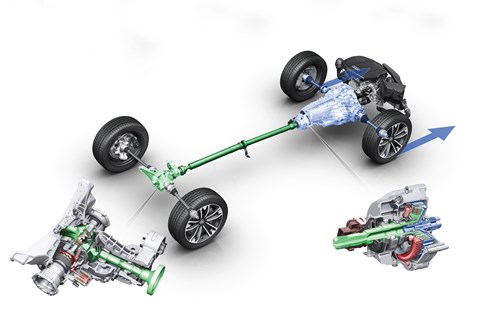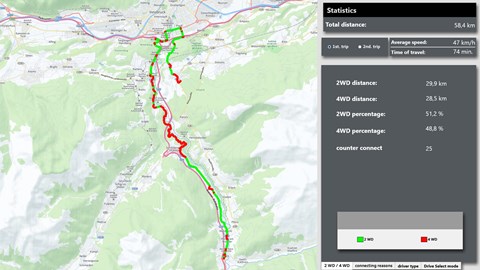► Audi’s latest Quattro awd system tested
► Goes on sale in new A4 Allroad mid-2016
► Seamless switching between 2wd and awd
From its very beginnings at the dawn of the 1980s, Audi’s Quattro system has principally stood for permanent four-wheel drive. But the high-tech latest-generation Quattro system, due for release in the new A4 Allroad later in 2016, is quite the opposite of permanent.
Unlike Audi’s previous Torsen and Haldex-based systems, the latest version features a set-up that allow the rear axle and differential to be decoupled entirely, cutting frictional losses and supposedly improving emissions and efficiency. The automatic switch between two- and all-wheel-drive reputedly takes milliseconds and the system’s even claimed to pre-empt the loss of traction before it happens.
Audi calls the latest system ‘Quattro with Ultra technology’ (Actually, it calls it ‘quattro with ultra technology’ – Audi’s marketing department isn’t a big fan of capital letters).
Audi’s new Quattro with Ultra system: what exactly is it?
The whole point of the new system is to improve efficiency, mitigating much of the usual fuel consumption and emissions penalty that’s part and parcel of conventional four- or all-wheel drive set-ups.
In the vast majority of circumstances the car operates in front-wheel drive mode, bringing the rear wheels into play only when absolutely necessary, and near-instantaneously. Audi reckons it can engage all-wheel drive mode half a second before it’s actually needed. So while it isn’t permanent four-wheel drive, Audi would argue that it kind of still is.
The new system does away with a traditional centre differential, binning the Torsen torque-biasing unit at the heart of the current Quattro system in longitudinally engined cars (although the Torsen system will continue in production alongside the new Ultra set-up).

How does it work?
At the heart of the system are two electronically controlled clutches – one at the back of the gearbox on the nose of the propshaft, and the second operating as a ‘de-coupler’ in the rear differential.
When the system switches to front-wheel-drive mode, the front clutch disconnects the propshaft and the decoupler in the rear diff opens, cutting the majority of frictional losses at the rear axle. The drag figure can never be zero, of course, but it’s negligible.
An electric motor reactivates the front clutch unit to re-engage all-wheel-drive mode. It’s claimed to be virtually seamless, taking 200-250 milliseconds to connect. Audi’s engineers chose an electric motor rather than a hydraulic system because the latter would need high pressures, and a very exact calibration to deliver the precise force required.
Presumably it’s packed with electronics?
Very much so. Myriad sensors, networked with a number of the car’s other control units, analyse everything from steering angle to lateral and longitudinal acceleration, the projected tyre contact patch (including how far the inside wheel will lift during cornering), engine speed and more every 10 milliseconds, and engage the rear wheels when they see fit. If there should be any kind of sensor failure, the default mode is all-wheel drive.
The system also examines the way you drive, and which Drive Select mode you’re in – if you’re a ‘dynamic’ driver (i.e. a bit of a hooligan), it will activate the rear axle sooner, and to a greater degree. It can also sense when the car’s towing a trailer, and apportion torque accordingly. As well as operating predictively, the system can also spring into action if it’s needed unexpectedly, for example encountering sheet ice halfway around a corner.
Carry-over from the existing Torsen Quattro system to the new one is ‘nearly nothing’, says Dieter Weidemann, Audi’s head of all-wheel-drive systems. ‘Just the propshaft, really,’ he adds. Work on the system started more than five years ago. ‘The project started from ourselves, there was no pressure from other departments at Audi [to instigate it]’ he says, adding ‘none of my team members were bored in the last five years.’
What kind of difference does it make?
Audi says its developers used an average of 0.3 fewer litres for every 62 miles covered than an equivalent Torsen system car over a test route around Ingolstadt.
The new system is said to use around 0.2 litres more fuel than a purely front-driven equivalent Audi (in Torsen system cars, it’s around 0.5). The Ultra system is 4kg lighter, despite having more components.
Isn’t Ultra a name for diesel engines?
True, Audi’s previously attached the Ultra tag to its thriftiest diesel engines. It’s now beginning to apply the name to any technology on its latest models that’s related to fuel efficiency or lower emissions.
Which cars will it appear on?
The system has been developed for Audi models with longitudinally mounted engines; A4 upwards, essentially. It’ll first appear on the new A4 Allroad, due for launch in mid-2016 with both TFSI petrol and TDI diesel engines, and will subsequently be rolled out across new Q5, A5 and Q7 models and beyond.
Depending on model, it will be available with both DSG auto and manual gearboxes, and with certain engines only. The system is currently designed to work with engines producing maximum torque below 370lb ft or so, meaning that RS variants and certain other engines will stick with developments of the current Torsen system.
Transverse-engined Audis – A3, A1, TT and so on – continue with their current systems for the time being, developed by VW rather than Audi.
What does it feel like to drive?
We drove the system in a pre-production Audi A4 Avant test vehicle, and it really was impossible to feel when the switch between two- and four-wheel-drive occurred. A telemetry system recorded what proportion of our journey it spent in which mode, and the results were surprisingly even: 51.2% in 2wd mode and 48.8% in awd. A twisty, mountainous section accounted for much of the time the rear wheels were engaged.

Incidentally, three weeks prior the same car had been driven around 1700 miles to the Arctic circle for three days, and did 90% of the trip in front-wheel-drive mode. Even on icy roads, the system activates front-drive mode in steady state driving.
Don’t other systems do more or less the same thing?
Wiedemann says the system cannot be compared with other front-to-rear disconnect systems, such as the Range Rover Evoque’s GKN-developed hydraulic actuation, because the Quattro system provides a more seamless transition. ‘We tried this [hydraulic system] and knew immediately it was not for us.’
Is the Quattro brand really such a big deal anymore?
In 2015 more than 40% of all Audis sold were Quattro models, the Q5 being the most popular of all. In total, Audi’s shifted 7m Quattro-equipped cars in the 36 years since the original Ur-Quattro’s launch in 1980.
‘Quattro is so important for the Audi brand,’ says Weidemann. ‘This is a big step for us, moving from a [centre] differential system to this system.’ And you sense it will be the biggest for the next few years: ‘You can change the Quattro brand [for the worse] if every year there is a new system.’
Weidemann is also insistent that Audi’s all-wheel-drive systems be developed in-house as much as possible. ‘I would never have taken the risk that Quattro [development] be in the hands of a [external] supplier.’
How Quattro changed the world on CAR+
Will it make the cars more expensive?
Cars with the new-gen Quattro system won’t be priced at a significant premium above models with the existing system, Audi tells us. It’s cost the company plenty to develop, though.
Weidemann suggests some customers talk themselves out of buying an all-wheel-drive car on the grounds that there would be maybe only five days a year when they’d truly need it. Might as well buy a front-drive car, avoid the extra fuel costs and park it in bad weather. The new system, in theory, offers the best of both worlds.
